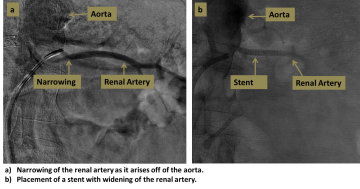Stent Graft Placement
Find your care
Our board-certified physicians diagnose and treat many vascular conditions. Call 310-481-7545 to learn more about interventional radiology services.
Treatment for
Gastrointestinal bleeding, vascular obstruction, biliary obstruction or leak, aneurysm, or dissection
Why it’s done:
A stent graft consists of a tube of metallic mesh with an impermeable fabric covering. The impermeable covering prevents leakage of blood or bile out through the stent, and prevents ingrowth of tissue into the stent. This may help keep the stent graft open. In cases of aneurysm or dissection of the aorta or other vessels, the stent graft can serve to repair the diseased vessel without resorting to open surgery.
How it’s done:
An interventional radiologist accesses the arterial or biliary system and navigates into the target vessel. The stent graft is then deployed in the area of abnormality, effectively creating an artificial bypass that excludes the abnormality and restores flow through the vessel.

Level of anesthesia:
Conscious sedation
Risks:
Bleeding, infection, arterial damage, incomplete exclusion of the abnormality (endoleak), thrombosis
Post-procedure:
Two to six hours of bed rest to prevent bleeding at the groin. No heavy lifting for 1 week.
Follow-up:
Depends on the clinical situation
For More Information:
For more information or to schedule an appointment with one of our IR physicians, please call 310-481-7545.